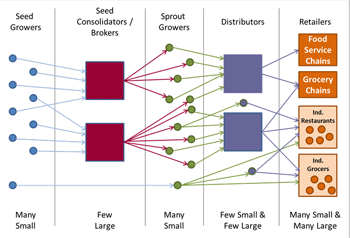
Topological mapping of food supply chains
The capability to trace contaminated foods forward (to consumers) and backward (to providers) is needed for rapid recalls during biological, chemical or radiological food contamination events resulting from terrorist attacks. The difficulties in adequately characterizing food supply chain topologies present a major uncertainty in conducting risk assessments. Our goal is to develop capabilities that stochastically map food supply chains to support food defense and understand, model and articulate risks. A system-level understanding is necessary because food pathogens traverse multiple parts of the food delivery system.
Challenges
- Supply chain topology varies markedly from one sector to another
- Supplier/customer relationships vary within sectors: some are enduring, others are market-based and highly transitory.
- Information about supplier/customer relationships is often proprietary and difficult to obtain
- Knowledge about supply chain topology is generally limited to direct supplier and direct customer
- Spot-market relationships are ephemeral as suppliers may change daily
Acknowledgements
Building on capabilities and knowledge developed across the past four years, this work was initiated by Sandia National Laboratories’ Laboratory Directed Research and Development program and continued with Department of Homeland Security funding through the NISAC program.
We work closely the reinsurance broker Aon Corporation, whose clients include a wide variety of companies representing all sectors of the food system. Sandia National Laboratories is currently in the process of establishing an umbrella CRADA with Aon.
We have a strong working relationship with the National Center for Food Protection & Defense (NCFPD), a DHS Center of Excellence located at the University of Minnesota. A Memorandum of Understanding has been agreed upon. NCFPD formally collaborates with a variety of major food corporations.
Journal Papers
The Value of Using Stochastic Mapping of Food Distribution Networks for Understanding Risks and Tracing Contaminant Pathways, Int. J. Critical Infrastructures, 8(2/3), pp. 216-224. September 2012
Review in Phys/Org: Probability maps help sniff out food contamination, September 2012
Conference Presentation
The Value of Using Stochastic Mapping of Food Distribution Networks for Understanding Risks and Tracing Contaminant Pathways, November 2011
Reports
A Risk Assessment of a Directed Asymmetric Attack on the US Populace Using the Quick-Serve Restaurant Supply Chain, 2009
Total Risk Assessment Methodology, 2008
White Paper on Food Defense Risk, 2008
